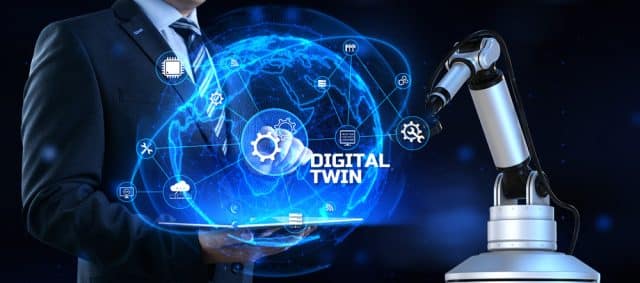Twice as nice? Who needs a digital twin?

The internet is always abuzz with new technology trends, and anyone who follows them will be familiar with the terms "digital twin" or "digital twin of an organization". Although digital twins have been around for several decades, the rapid rise of Internet of Things (IoT) technology has made the concept more widely considered a tool of the future. So, as digital twins increasingly model systems of interconnected things, what potential does the technology hold to orchestrate processes, people, and things in a sophisticated way that’s beneficial for everyone?
This article defines what a digital twin is, and suggests where the technology is headed in our increasingly interconnected world.
What is a digital twin?
Digital twins are virtual replicas of a physical product, process, or system that bridge the physical and digital worlds. Interestingly, the concept of digital twin technology has been around for longer than you may think. When the Apollo mission was developed, scientists at NASA created a digital twin to conduct experiments on the clone before the mission started.
Today’s digital twins use sensors to collect real-time data about a physical item, which is used to create a virtual duplicate of the item. The digital duplicate can be optimized, manipulated and analyzed to test different scenarios in a risk-free environment. Digital twins also integrate artificial intelligence (AI) and machine learning (ML) to bring together data, algorithms, and context. This enables organizations to:
- Get new answers to new questions
- Test new ideas
- Uncover problems before they happen
- Monitor items remotely
The advantages of digital twins include:
- Virtual representation of a virtual ecosystem map of assets across operations and business processes using accessible, real-time data flowing across connected systems helps automate workflows, mitigate risks, and drive greater sustainability.
- Data intelligence allows for constant monitoring of any entity, system, or device, shared to interactive dashboards in real-time. This thread of corresponding data allows organizations to overcome data and organizational silos to truly understand how well their operations are performing.
Secure components of digital twins can be shared with various stakeholders in the ecosystem, enabling better collaboration and communication, regardless of location.
How are digital twins being used today?
In the past, digital twins were used to improve the performance of single assets, such as wind turbines or jet engines. These days, they connect not just one asset, but systems of assets and devices or even entire organizations. As they combine more and more assets with information about processes and people, their ability to help solve complex problems is also increasing.
Digital twin energy management
Energy management platforms such as Smarter Technologies’ SmarterView essentially create a digital twin of the energy profile of a smart building. Before making changes to the physical environment, energy managers can manipulate energy consumption in the digital realm to assess its impact and make decisions accordingly. For example, one could test the effect of replacing an old appliance or piece of equipment with a new model that’s more energy-efficient and see how long it would take for the upgraded model to pay itself off.
Product development
Using digital twin technology, organizations can predict the future performance and analyze potential process failures of a product, even before the final design is approved. This scenario-based testing allows engineers to predict the failures and risks and apply mitigation in simulation labs.
Asset management
The digital thread produced by digital twins enables data flows. It provides an integrated view of asset data, helping to optimise product life cycles by identifying gaps in operational efficiencies and producing a wealth of process improvement opportunities.
Healthcare
By creating a digital twin of a hospital, doctors, hospital administrators, and nurses can get powerful, real-time insights into patient health and operational workflows. For example, by using sensors to monitor patients and coordinate equipment and staff, hospital staff can offer a better way to analyze processes and alert the right people when immediate action is needed. This results in reduced emergency room wait times and improved patient flow, which decreases costs and improves patient outcomes.
By the end of this decade, scientists may even come up with a fully functional digital twin of a human being that can help make massive strides with medical research, drug testing and proactive injury prevention.
Commercial real estate and building management
Digital twins allow building operators to bring together previously unconnected systems to gain new insights, optimise workflows, and monitor processes remotely. The technology can also give occupants more control over their personal workspaces and environmental conditions, thereby enhancing their experience. By optimizing building systems using digital twins, operators can reduce costs, avoid future costs, increase occupancy rates, and improve the overall asset value of the building.
Supply chain optimization
Supply chains have undergone massive disruption and instability in the last few years in the wake of the COVID-19 pandemic and the war on Ukraine, with shortages of raw materials, and finished products impacting daily life. Supply chain visibility has become more important than ever before. Deploying digital twin technology enables companies to digitize their end-to-end supply chains, using intelligence to automate and optimise operations, reduce risk, and increase on-time delivery.
What is the future of the digital twin?
For companies and organizations already using smart technology, digital twins are the next step in the digital journey. Today’s digital twin technology can be used in new and mature ways, integrating smart sensors, AI, and ML to solve the most prominent organizational challenges, while improving efficiencies, optimizing processes, detecting problems before they occur, and innovating for the future. It’s important to note, however, that maximizing the usefulness of digital twins requires high-performing databases that can pull together and process various data sets in real time.
If your organization is interested in producing not only better business outcomes, better environmental outcomes, and better social outcomes, digital twins are undoubtedly worth exploring.
Image credit: [email protected]/ depositphotos.com

Matthew Margetts is Director of Sales and Marketing at Smarter Technologies. His background includes working for blue-chip companies such as AppNexus, AOL/ Verizon, and Microsoft in the UK, Far East and Australia. Smarter Technologies tracks, monitors and recovers assets across the globe in real time, providing asset tracking systems to the open market and fulfilling the world’s most complex asset tracking requirements. Our services cover a vast array of business sectors, products and equipment from container or pallet tracking to military-grade devices; and can be used across a broad spectrum of industries.
